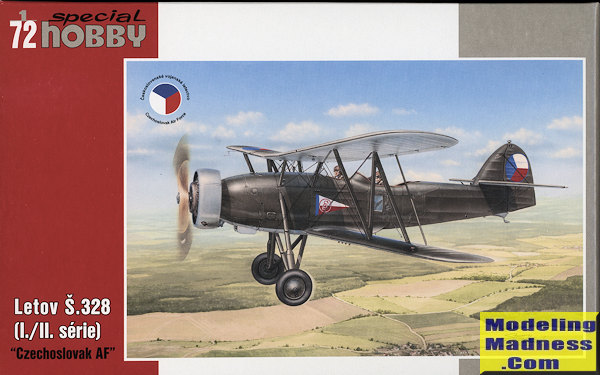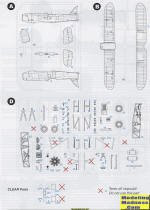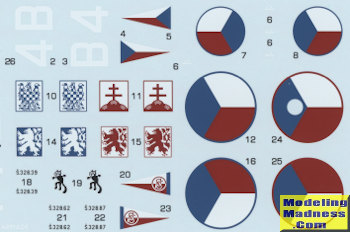
Special Hobby 1/72 Letov S. 328 series I/II
| KIT #: | SH 72145 |
| PRICE: | $24.50 SRP |
| DECALS: | Four options |
| REVIEWER: | Scott Van Aken |
| NOTES: | Short run. One resin part |

| HISTORY |
Design work started in 1932 to meet a requirement from the Finnish Air Force although they never accepted the type. It first flew in 1934 and began equipping the Czechoslovak Air Force the following year. The machine was made in two versions—with wheeled undercarriage for land use and with floats for water operations. Although Czechoslovakia was a land locked nation, a floatplane variant was necessary for a Czechoslovak anti-aircraft artillery training depot in the Bay of Kotor (now in Montenegro) and four were built as the Š-328v. (v stood for vodní or water). It was used as a reconnaissance aircraft, light bomber and ground-attack aircraft for the Czechoslovakia Air Force during the mid and late 1930s and in that same role during the early months of World War II, when the Slovak Air Force came under German control following its occupation of Czechoslovakia in March 1939. 13 planes from first production batch was tested as night fighters armed with 4 7,92 mm vz.30 machine guns in the wings and 2 movable vz.30 for the observer. These were later modified for normal use because without radar their effectiveness was minimal. At the time of the Munich agreement, which ended the Sudeten crisis the Czechoslovak Air Force had 227 planes in operational units and 87 in training schools and mobilisation depots. Production continued even after German occupation of Czechoslovakia until 1940, the last planes being 30 Š-328 produced for Bulgaria, and 50 planes of that type ordered by Slovakia in July 1938. Altogether, 412 Letov Š-328 were produced.
The Letov Š-328's combat record is vague but some sources suggest that some Š-328 landplanes may have been used during the Spanish Civil War however there is no evidence to confirm this and is likely a misidentification of another type. The Germans used captured Š-328s both as trainers and in the night attack role on the Eastern Front in the Winter of 1942-43. The Germans handed over some of these machines to their allies, Bulgaria, and Slovakia.
The Slovak Š-328s carried out reconnaissance and bombing sorties in support of the Slovak participation in the Invasion of Poland in September 1939. Following Slovakia's participation in the German Invasion of the Soviet Union in 1941, Slovak Š-328s were used for patrol and reconnaissance flights and few of them also attacked soviet trucks and cars. They were again used in anti-partisan operations in western Ukraine in the summer of 1942. At least 11 Slovakian aircraft were seized by Slovak insurgents and flown against the Germans in late 1944 during the Slovak National Uprising in September to October 1944. The unit never had more than 3 planes operational at time, but they were an important asset. On 7 September 1944 this aircraft achieved one of the last shoot-down of an enemy aircraft achieved by biplane, when a patrolling Š-328 was attacked by a reconnaissance Focke-Wulf Fw 189. The Fw 189 was damaged by machine gun fire and forced to land in an area controlled by the insurgents.
| THE KIT |
 Considering that one doesn't often see kits of general purpose prewar biplanes, the S.328 has had kits produced in all the major scales. Prior to the release of this kit in 2015, KP provided 1/72 modelers with their Letov fix. Now one could easily say that kit from the 70's has been eclipsed by this one from Special Hobby. This particular kit is the Czech Air Force boxing and you can tell from the 'do not use' bits that a floatplane variant is one of these other boxings.
Considering that one doesn't often see kits of general purpose prewar biplanes, the S.328 has had kits produced in all the major scales. Prior to the release of this kit in 2015, KP provided 1/72 modelers with their Letov fix. Now one could easily say that kit from the 70's has been eclipsed by this one from Special Hobby. This particular kit is the Czech Air Force boxing and you can tell from the 'do not use' bits that a floatplane variant is one of these other boxings.
The kit is on three grey sprues with a clear sprue for lights, windows and windscreen. Wings, horizontal stab and rudder are single piece moldings. There is a very well done interior as Special Hobby has included full interior framing. This is a good thing as one can easily see inside the plane through the large openings. This kit is the wheeled version so all the floatplane struts are extraneous to your needs.
One of the more complex parts of the build is the rear defensive guns. There are 12 pieces to this construct with one of them being a choice between 'ready to fire' and a stowed position. The engine fits between two cowling halves. It would be nice to have had this as a single piece, which would eliminate the inevitable seam work. Interior is very well done with such bits as a camera in behind the pilot. A resin control stick is included as apparently the plastic one is the wrong shape. I noticed that there is no rear seat for the gunner so apparently this poor fellow had to stand the entire flight.
All the attachment points for the struts and landing gear as well as for the light bomb racks are very shallow and would undoubtedly benefit from drilling outThe only racks actually used in this boxing are those on the fuselage c enterline and then these differ by which markings option you use. This is a biplane so a rigging diagram is provded. nothing really onerous, but still more complex than a Fokker D. VII.
enterline and then these differ by which markings option you use. This is a biplane so a rigging diagram is provded. nothing really onerous, but still more complex than a Fokker D. VII.
Instructions are well done with Gunze paint references. All four options are in Khaki over Silver and differ by code letters/number and the unit badge on the fuselage. One has an unpainted tail section that is listed as being a 'dirty white'. Decals are nicely printed and are sure to be quite thin. Note that I 'autoscanned' the decal sheet and it missed the codes for three of the options.
| CONCLUSIONS |
| REFERENCES |
https://en.wikipedia.org/wiki/Letov_%C5%A0-28
June 2016
Copyright ModelingMadness.com
If you would like your product reviewed fairly and fairly quickly, please contactthe editor or see other details in the